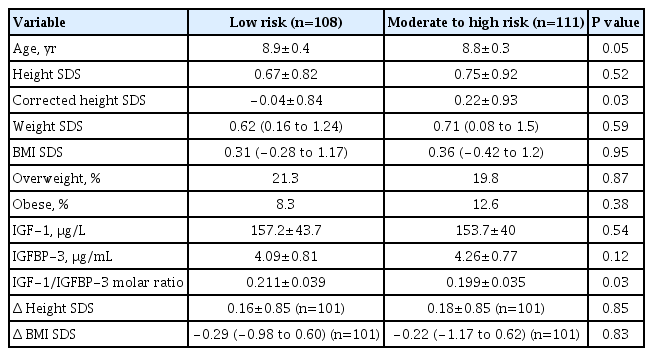Search
- Page Path
- HOME > Search
Brief Report
- Diabetes, Obesity and Metabolism
- Growth in Children with HLA-Conferred Susceptibility to Type 1 Diabetes
- Liisa Saare, Aleksandr Peet, Vallo Tillmann
- Endocrinol Metab. 2022;37(1):175-179. Published online February 28, 2022
- DOI: https://doi.org/10.3803/EnM.2021.1262

- 2,450 View
- 93 Download
-
 Abstract
Abstract
 PDF
PDF PubReader
PubReader  ePub
ePub - The incidence of type 1 diabetes (T1D) is increasing throughout the world. This trend may be explained by the accelerator hypothesis. Our study investigated growth, its biochemical markers, and their associations with the development of diabetes-associated autoantibodies (DAAB) in 219 children with genetic risk for T1D. Subjects were divided into risk groups based on their human leukocyte antigen genotype. Children in the moderate- to high-risk group were significantly taller when corrected to mid-parental height and had a lower insulin-like growth factor 1 (IGF-1)/IGF-1 binding protein (IGFBP-3) molar ratio than those in the low-risk group (corrected height standard deviation score 0.22±0.93 vs. –0.04±0.84, P<0.05; molar ratio 0.199±0.035 vs. 0.211+0.039, P<0.05). Children with DAAB tended to be taller and to have a higher body mass index than those with no DAAB. Our results suggest that the accelerator hypothesis explaining the increasing incidence of T1D may not solely be dependent on environmental factors, but could be partially genetically determined.

Case Report
- A Case of Fulminant Type 1 Diabetes Mellitus with Human Leukocyte Antigen DR4-DQ4.
- Ye Ri So, Ja Won Koo, Young Hak Cho, You Cheol Hwang, Kyu Jeung Ahn, Ho Yeon Chung, In Kyung Jeong
- Endocrinol Metab. 2012;27(4):314-317. Published online December 20, 2012
- DOI: https://doi.org/10.3803/EnM.2012.27.4.314
- 1,633 View
- 20 Download
-
 Abstract
Abstract
 PDF
PDF - The clinical characteristics of fulminant type 1 diabetes are abrupt onset of disease, very short (<1 week) duration of diabetic symptoms, ketoacidosis at diagnosis, negativity for islet-related autoantibodies, virtually no C-peptide secretion (fasting plasma C-peptide <0.3 ng/mL), a near normal hemoglobin A1c (HbA1c) level and an elevated serum pancreatic enzyme level. The pathogenesis has not yet been clarified, however the involvement of both genetic background and viral infections has been suggested. We reported a case of fulminant type 1 diabetes. A 37-year-old woman was admitted with stuporous consciousness to our hospital. Four days prior to the admission, she was hospitalized with the diagnosis of acute pancreatitis in another hospital, and at that time her glucose level was 79 mg/dL. Three days after the hospitalization, her state of consciousness became stuporous and she was transferred to our hospital. The laboratory results were as follows: pH 6.94, glucose 1,602 mg/dL, and HbA1c 5.5%. She was negative for islet-related autoantibodies and viral antibodies. HLA haplotypes were DRB1*04:05/*04:06, DQB1*03:02/*04:01 which might be a considerable risk allele for fulminant type 1 diabetes. She was diagnosed with fulminant type 1 diabetes, and has been treated with multiple component insulin regimens.


 KES
KES
 First
First Prev
Prev



